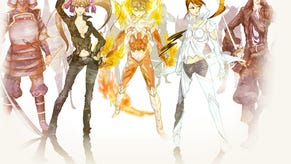Face-Off: El Shaddai: Ascension of the Metatron
Don't Enoch it.
It's not all doom and gloom for the PS3 version though. According to our inspection of each disc's table of contents, the higher Blu-ray capacity seems to afford Sony's machine more room for video data (2.66GB compared to the 360's 1.47GB), suggesting higher levels of bandwidth for FMVs.
This results in a tangible difference. To our eyes, artifacting was indeed a minor issue in the 360's video sequences, although only noticeable during the darker, more frenetic moments towards the game's climax. This is curious as the 360 version only uses up 4.2GB of the DVD's total 6.8GB capacity. Factoring in Microsoft's release of newer discs with 1GB less security bloat, this would imply there could potentially have been up to 3GB of unused space - enough to match its competition in this regard. The situation echoes that of the 360 release of Final Fantasy XIII, where additional space was available but inexplicably unused. Either way, the improved image quality in the video-driven cinematics is a clear point in favour of the PS3 version.
Now, onto performance. The gameplay itself ranges from 2D platforming reminiscent of Housemarque's acclaimed Outland, to 3D combat action that clearly calls on the director's experience with Devil May Cry. It even shows up with a racing section, in abrupt fashion, to keep you on your toes. Through all of this, El Shaddai subscribes to the same frame rate philosophy as its spiritual predecessor, Okami, and will willingly drop below the target - 60FPS in this case - in favour of adding more enemies, particle effects and destructible objects to a scene.
Both consoles have v-sync engaged at all times, but frame rates can be extremely variable, with different permutations depending on the level. During the introductory arctic section, for example, both the PS3 and 360 will alternate between a locked 30 or 60FPS depending on load, only daring to drop frames when physics are involved. Similarly, it's locked at 30FPS during cut-scenes on both platforms, with very little to distinguishing the two.
However, things change radically during 3D traversal and combat, with the PS3 often commanding the 50-60FPS range while the 360 fluctuates around the 40-50FPS mark. Both consoles will take a hit at equivalent points of strain, but it's often more so for the latter console in these instances. It's a similar scenario when it comes to levels set on a 2D plane, with both versions dropping frames whenever new graphical elements, such as shifting light sources, are introduced.
Additionally, it appears the 360 has a disdain for any physics-based action - often taking a bigger hit when lines of objects are destroyed by a charged Gale weapon, for example. This is consistent with other titles that utilise the PS3's SPUs to handle Nvidia's PhysX engine, where the 360's triple-core setup can sometimes show its limitations. With all this being the case, it's not cut-and-dried: Microsoft's box can still overtake its HD rival in some instances, but for the most part the PS3 has the edge in performance.
So, overall, it's a mixed bag. In some ways it feels like the game was released before it was fully optimised for either console, but there's a lot to admire despite its technical flaws. While the beautiful artistry behind each level is only viewable through a low, sub-HD window on both 360 and PS3, the sheer spectacle of the adventure still manages to shine through and impress. In summary, the PS3 offers fewer compression artifacts during FMVs but demands a certain level of tolerance towards aliasing. If it's image quality you want though, the 360 is the clear winner, with a redeeming coat of 2x MSAA, and less pixellation on certain textures.
Meanwhile, it must be admitted that El Shaddai's irregular frame rate does have a negative impact on the handling of play on both formats. When it holds a full 60FPS during the less strenuous sections, it convincingly matches its genre contemporaries in terms of responsiveness - even the buttery-smooth Bayonetta. But sadly, the reality is that these fluctuations are destined to make controller input inconsistent at times when it matters most. Nevertheless, if it's a more fluid gameplay experience you're after, from beginning to end, the PS3 version would be our recommendation.
Article by Thomas Morgan.




